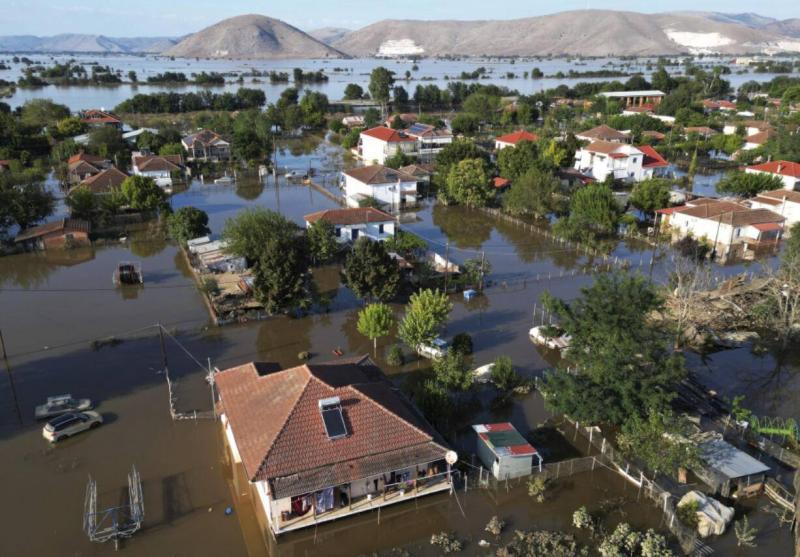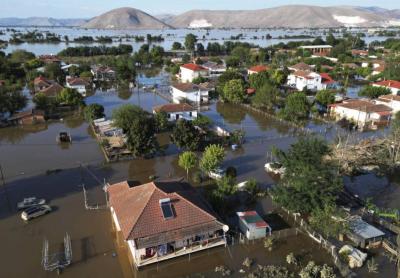In September alone, floods struck eight countries around the world, marking some of the worst scenarios of climate change and natural disasters not witnessed this century. However, scientists largely agree there is no scientific confirmation of a direct link between the two. Yet, through anecdotal observation, tangible facts have emerged as follows: global warming has caused the worst heatwaves in traditionally cooler European countries, leading to water that evaporated into the atmosphere, which then poured down in torrential floods, such as the one in Libya. According to witnesses, the rainfall was equivalent to an entire year's worth of rain, comparable to the explosion of a Hiroshima bomb, with Libyans stating, "We witnessed the Day of Judgment with our own eyes."
According to recent events, "The Indian Express" links the latest series of floods to rising global temperatures. Therefore, it suggests that flood scenarios in various regions could potentially be a direct consequence of climate change. Nevertheless, attributing any flooding event to climate change is a pursuit not supported by scientists.
### Libya's Losses
The newspaper tallies Libya's material and human losses just in September alone: "More than 11,000 people were killed and 30,000 displaced in Libya after heavy rains caused floods that occur once a century, leading to dam failures and the destruction of buildings, according to local officials. This disaster came after reports of devastating floods in four continents during the first ten days of September. Torrential rains flooded parts of central Greece, northwestern Turkey, southern Brazil, central and coastal Spain, southern China, Hong Kong, and the southwestern United States. While a Mediterranean storm named 'Daniel' caused floods in Libya, Greece, and Turkey, a hurricane caused chaos in Brazil, while another storm known as Typhoon Haikui led to flooding in Hong Kong and China."
The newspaper notes that "the latest series of extreme climate fluctuations came on the backdrop of rising global temperatures. Therefore, it makes sense to observe flooding in different areas as a direct consequence of climate change—studies have shown that global warming likely impacts flooding. However, attributing any flooding event to climate change is a challenging endeavor for the following reasons: firstly, there is insufficient data to monitor shifts over time. Secondly, several other factors have substantial effects on the frequency and intensity of floods."
### The Link Between Climate Change and Flooding
What is the relationship between climate change and floods? What factors trigger flooding in the region? The report outlines the following steps:
#### Climate Change and Weather Factors
The newspaper connects climate change with weather factors: "As temperatures rise, there is more evaporation from the Earth, oceans, and bodies of water, meaning that a warmer atmosphere can hold more moisture—experts suggest that for every one-degree Celsius rise in average temperature, the atmosphere can hold approximately 7% more moisture. This makes storms more severe because it leads to increased intensity of precipitation and/or its duration and/or frequency, potentially resulting in severe flooding."
A study published in "Nature" indicated that since 2002, extreme rainfall rates have been closely associated with rising temperatures. The study also noted that as mercury levels rise, the planet has become both drier and wetter simultaneously. The study stated: "Warmer air can absorb moisture from the soil, exacerbating drought conditions. Conversely, warm air can also hold more moisture, which means it can transport more water to already moist areas. Rising sea levels are another example; global temperature increases have led to the melting of glaciers and ice sheets, resulting in rising sea levels, thereby putting coastal areas at greater risk for flooding. According to a 2022 report by the National Oceanic and Atmospheric Administration (NOAA), the average global sea level has risen by approximately 21-24 centimeters since 1880."
#### Implications of Rising Water Levels
"Nature" clarifies: "Higher backwater levels mean that deadly and destructive storms, like those linked to Hurricane Katrina, 'Superstorm' Sandy, and Hurricane Michael—surge further inland than they did before." It further adds that "rising sea levels also mean more frequent flooding due to high tides, sometimes referred to as 'sunny day flooding' since they are generally not deadly or hazardous, but they can be devastating and costly."
### Challenges in Attributing Floods to Climate Change
One issue with ascribing floods to climate change is that historical records are limited, especially regarding the most catastrophic floods, which occur less frequently. Furthermore, as previously mentioned, various factors (such as local weather patterns, soil type, and the terrain of the affected area) contribute to determining responsibility for floods in the region.
Similarly, scientists have yet to reach a consensus on the relationship between hurricanes and climate change. However, this does not apply to all extreme weather events, as there is enough evidence to prove that global warming has led to an increase in hot days. Climate scientist Daniel Swain from the University of California, Los Angeles, explained to the "New York" that "floods occur somewhere at the intersection of heatwaves (this is evident) and hurricanes (still unconfirmed)."
### Other Contributing Factors to Flooding
Local conditions such as terrain and soil moisture levels also influence flood development. For instance, drier soil is better able to absorb most rainfall compared to moist soil; however, both dry and moist soil are incapable of absorbing a lot of water during heavy rains.
Weather patterns also play a significant role. For example, the 2022 floods in Australia inundated large parts of the country's eastern coast due to persistent heavy rainfall. A high-pressure pattern in the Tasman Sea prevented the weather system from moving east. This led to continued rain and supported the formation of a low-pressure area off the eastern coast, resulting in rainfall in the Greater Sydney area in early March, according to a team of researchers whose study on the floods was recently published in "Nature." The situation worsened with rain falling on already wet surfaces, creating ideal conditions for flooding.
The magazine notes: "While we need to rapidly reduce greenhouse gas emissions to mitigate the harm caused by climate change, the role of climate change in this heavy rainfall event remains unclear."
### The Role of Vegetation
Deforestation is another factor contributing to floods. Trees stabilize the soil, and their roots are known to absorb excess surface water, directing it to groundwater reservoirs. Without many trees in an area, the natural impediment that prevents the unrestricted flow of water disappears, leading to flooding. A study conducted by researchers from Charles Darwin University in Australia and the National University of Singapore in 2007 found that with each 10% increase in deforestation, the risk of flooding rises by up to 28%.
Inadequate maintenance of infrastructure can also lead to flooding. In the Libyan coastal city of Derna, the severity of the floods was immense because heavy rainfall caused two of the city's dams to burst—they collapsed under the pressure of the water that had accumulated behind them during the storm. Several reports indicated that the dams may have been in a state of disrepair due to government neglect, as cracks had begun appearing as far back as 1989.
Human encroachment on floodplains is another cause of floods, according to experts. In July, Delhi experienced its worst flooding in history. The Yamuna River level rose to 208.66 meters, submerging the ring road and flooding Kashmir Gate, civilian lines, and Ito and Rajghat. An investigative committee found that the primary cause of the flooding was excessive encroachment.
In conversation with "The Indian Express," KT Ravindran, chief architect and urban planner, noted that the floods in Delhi highlighted poor management of water networks and the low capacity of the city's sewage system.




